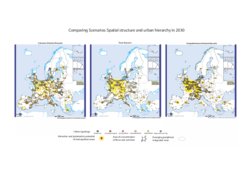Territorial futures in 2030
Thinking towards the future is an essential precondition for investigating where policies are necessary and how they should be shaped. Development has its own momentum, but policies can make a difference.
In order to support a debate at European level and the involvement of regions, cities and larger territories, ESPON has developed several spatial scenarios, exploring alternative directions of possible trends and driving forces related to the future territorial development of Europe. These scenarios are not to be seen as predictions, but as possible images of the future.
Concept/method/measurement
For the scenario building process, the most significant driving forces likely to shape the evolution of the European territory in the decades to come were identified. Then, model-based approaches simulating the regional evolutions in demography, economic development and transport were combined with creative and speculative contributions, considering a series of relevant scenarios hypotheses.
The maps compare the spatial structure and urban hierarchy of Europe in 2030 according to three scenarios: a trend scenario resulting from practically unchanged policy orientations, and two contrasting policy scenarios developed on the basis of the trend scenario. The scenario on the right assumes a shift of policies to focus on global European competitiveness, whereas the scenario on the left assumes a new combination of policies oriented towards economic, social and territorial cohesion.
Interpretation
For the trend scenario, the map shows a remarkable concentration of activity in the metropolitan areas of the central economic area, the Pentagon, but also in less central regions (mainly capital cities and other European engines). As a result, the Pentagon has extended outwards along main transport corridors in the direction of major metropolitan areas like Barcelona and Madrid, Rome, Glasgow, Copenhagen, Stockholm and Oslo, Berlin and Warsaw, Prague, Vienna and Budapest.
In the competitiveness-oriented policy scenario, the attraction and polarisation potential of metropolitan areas is particularly strong and activities are concentrated in the traditional Pentagon. Only very few metropolitan areas beyond it are able to generate significant attraction and polarisation effects. The area of concentration of flows and activities is much more limited than it would be following current trends. It covers only parts of the traditional Pentagon (formed by London, Paris, Hamburg, Munich and Milan) although it also extends out along a few major corridors, to reach Vienna and Copenhagen.
Finally, the cohesion-oriented policy scenario reveals a more diffused pattern as far as the attraction and polarisation potentials of metropolitan areas are concerned. Urban settlements are characterized by greater polycentricity, stretching over larger parts of the European territory than in the trend scenario. In contrast to the trend scenario, several well-performing integrated zones have emerged outside the Pentagon, also in more peripheral areas. The Pentagon has grown and includes a larger number of cities outside this area.
Conclusion
Generally speaking, a competitiveness-oriented policy mix is more likely to result in territorial imbalances with enhanced differences in living conditions and polarisation between areas. Regarding a cohesion-oriented policy mix, it tends to produce a significant amount of added value in terms of reduction of territorial imbalances but its economic and technological performance will probably be lower than that of the two other scenarios.
Comparing the outcomes of these scenarios mainly highlights the spatially differentiated impacts of policies, and thus the importance of taking into account the territorial dimension in policymaking.
Further reading
